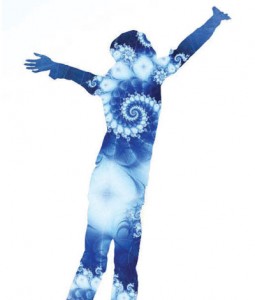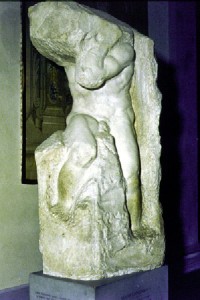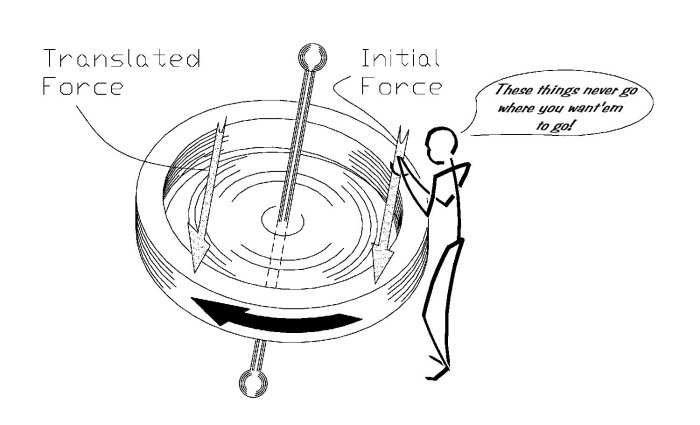Fascial Unwinding Cancels Torsional Forces
Fascial Unwinding Cancels Torsional Forces by Dorothea Blostein
Over the past two years I have undergone a difficult process of large-scale fascial unwinding. In this article I describe my personal impression of the mechanics and forces in fascial unwinding. My impressions have been shaped by treatments provided by four manual therapists (who are not to blame for any misconceptions in this article): osteopath Robert Black, chiropractor Brent Helmstaedt, registered massage therapist Kristin Kelly, and Feldenkrais® practitioner Jennifer Payne.
I propose a model of fascial unwinding in which adhesive forces are overcome to allow a torsional force in the fascia network to cancel a countertorsional force. Unwinding leaves the fascia network in a state of lower energy. This energy reduction is one of the driving forces behind spontaneous body movements associated with fascial unwinding.
At present, my introspection provides the only evidence to support the proposed model. I am publishing these speculative thoughts in case they are useful to others. Perhaps they will lead to discussion and experimentation.
Michelanglo, Atlas Captive, 1520. Seen statically, this captive figure is endlessly straining against the adhesive forces in the marble. But imagine the marble in motion and you have an inspiring symbol of fascial plasticity, the body emerging to freedom.
Fascia forms a connected network that spans the entire body (Myers, 2001). Terminology for fascia varies; standardized terminology is proposed by Langevin and Huijing (2009). Fascia has plasticity, meaning that the structure of the fascia network can change over time (Schleip, 2003).
Pantyhose and wetsuits are suggested as analogies for explaining fascia to patients (Bose and Lesondak, 2009). Some of us know from personal experience how difficult it is to straighten out twisted pantyhose or a twisted wetsuit! Usually it’s easiest to just take the darn thing off and start over. Unfortunately, our bodies do not have this option for straightening out the fascia network. Instead, the body goes through fascial unwinding, a process that can take several years in severe cases.
Fascial unwinding has several definitions. In a recent survey paper, it is defined as a type of indirect myofascial release technique (Minasny, 2009). In other circles, fascial unwinding refers to spontaneous movements (for example, see http://www.youtube.com/watch?v=1QM-8_DwArU). Fascial unwinding is closely related to pandiculation (stretching and yawning); Bertolucci (2011) discusses the role of pandiculation in maintaining the myofascial system.
A model of a biological system is a simplification: the model characterizes selected aspects of a complex physical system. A model can be used for understanding and teaching, as well as for formulating testable research hypotheses. Tensegrity and viscoelasticity are two well-established models for biological systems. Ingber, Heidemann, Lamoureux and Buxbaum (2000) debate the strengths and weaknesses of tensegrity and viscoelasticity for modeling at the cellular level. Myers (2001) provides a popular and accessible presentation of tensegrity and its use to model bones (under compression) and fascia (under tension). The body’s ground substance can be modeled as a viscoelastic liquid. Viscoelastic liquids have marvelous properties: if you pull on them suddenly, they are tremendously strong, like a solid, but left on their own, they flow around like a liquid. To experience this for yourself, use this goop recipe to make a viscoelastic liquid out of a mixture of water, white school glue, and borax.
Here is a description of the elements of the proposed model for fascial unwinding.
- The fascia network naturally tends to a configuration that minimizes energy. An idealized initial state is used as a reference. In the initial state, the fascia network is straight, meaning that torsional forces in the fascia network are at a minimum. Thus the initial state is the configuration of lowest energy.
- Injury can introduce torsional forces into the fascia network. When a torsional force is introduced, this necessarily introduces an equal and opposite countertorsion elsewhere in the fascia network. A torsional force applied to some part of the fascia network causes twisting in that part of the network. The amount of twist – the angle of rotation – depends on the torsional stiffness of the affected fascia. Even small angles of twist are damaging in many parts of the body; the body compensates by increasing torsional stiffness of affected fascia and/or by distributing the torsional force to other parts of the fascia network.
- Adhesive forces can prevent a twist and countertwist from meeting and cancelling out. Thus the adhesive forces hold the fascia network in a higher energy state.
- Fascial unwinding is the process of overcoming adhesions to bring together and cancel a twist and countertwist. This cancelation of torsional forces moves the fascia network from a higher energy state to a lower energy state.
- Fascial unwinding can be facilitated in two ways:
- Place the body into a position that aligns a twist and countertwist along a straight axis. Applying force along this unwinding axis helps to bridge the adhesion that separates twist and countertwist.
- Reduce adhesive forces, by breaking up scar tissue or by increasing circulation to reduce the viscosity of the ground substance.
- Fascial unwinding axes have a fractal organization. This arises because the fascia network has a fractal structure. (Fractal means that a zoomed-in view of a small region of fascia looks similar to a zoomed-out view of a large region of fascia.) During self unwinding the perceived locations of several small unwinding axes can be used to find larger-scale axes along which fascia needs to unwind.
- Positive feedback assists the process of fascial unwinding, with the effect that successful unwinding facilitates further unwinding. When unwinding succeeds, this reduces torsional forces in some part of the fascia network. I hypothesize that a reduction in torsional forces triggers a local reduction in the viscosity of the ground substance. The less-viscous ground substance allows fascia to move more easily, further decreasing the local strain on the fascia, triggering further reduction in ground-substance viscosity. Also, less viscous ground substance allows fluid circulation to improve, thereby encouraging further reduction of viscosity.
Various investigations could be undertaken to refine this model. One problem is to study how the body reacts to torsion. My hypothesis is that high torsional force triggers an increase in local torsional stiffness (for example, an increase in the viscosity of the ground substance, or a stiffening of the fascia). Such increase in torsional stiffness is advantageous because it reduces the angle of twist for a given torsional force, thereby reducing the degree to which the torsional force impacts the mechanical performance of the affected body part. The entire fascia network responds to a local injury, so a torsional force can be distributed to body parts that are far from the site of injury.
It would be interesting to model injuries and how they introduce torsional forces into a fascia network. An impact injury could create scar tissue and adhesions that cause long-term displacement of fascia, thus giving rise to torsional and countertorsional forces elsewhere in the fascia network. Alternatively, long-term asymmetrical body use might introduce imbalances and twists. Another possibility is that localized proprioception reversals can cause incorrect reflexive responses, increasing torsional forces instead of reducing them. (Eye movement exercises can be used to correct proprioception problems in the head and neck. The stability of vision is discussed by Harris (1965): in situations where vision information disagrees with the position sense, the disagreement is resolved by changes in the position sense.)
Computer simulation can be used to investigate the behavior of the model. I propose simulating a tensegrity model that has been extended to include adhesive forces as well as tension and compression forces. A single scale can be used for model elements that are under compression (these represent bone) and fractal structure can be used for model elements that are under tension (these represent fascia). Torsional forces and adhesions can be introduced during the simulation. It would be interesting to develop measures for characterizing a tensegrity structure in terms of its “structural buffering capacity”: how much adhesion and twisting can the tensegrity structure tolerate, while still maintaining a specified level of functionality? Related work includes the study of tensegrity and adhesions at the cellular level (Stamenovic 2006), tensegrity models of biomechanics (Levin 2002 and 2006), and engineering methods for designing tensegrity structures that minimize construction cost while meeting stated load-bearing requirements (Rhode-Barbarigos, Schmidt, Ali and Smith, 2009). Computer simulation offers the opportunity to study how localized damage in a tensegrity structure causes a gradual, system-wide degradation of function.
Physical realizations or computer simulation could be used to see whether this model of fascial unwinding can give rise to spontaneous movements as the modeled fascia network undergoes “self unwinding” to return to a lower energy state. If successful, this could offer a mechanical explanation for the spontaneous movements people exhibit during fascial unwinding. I conjecture that smooth, flowing types of spontaneous movement are due to the body aligning itself along a shifting axis of fascial unwinding. In contrast, fast oscillatory movements arise when the body is improperly aligned along an axis; the oscillation calms down when alignment is corrected by a manual practitioner or by the patient during self unwinding. Oscillatory movements can also arise when the body oscillates between several possible unwinding axes; in this case unwinding is unsuccessful and the oscillatory movements can repeat indefinitely.
I conclude with personal observations about self unwinding. Fascial unwinding is mostly sub-conscious and reflexive, but I can consciously take actions to assist unwinding. Helpful feedback is provided by the amount of spontaneous body movement: if I succeed in lining things up correctly, the external body movement stops. This reminds me of balancing a spinning basketball on my finger: if I do this correctly, my hand and the ball are stable, whereas if I do it incorrectly my hand and the ball wobble around.
For many months, I found it difficult to react properly to my sensations of the shifting axes of fascial unwinding: an axis moves in an unexpected direction when I (internally) apply a force in a direction that is perpendicular to the axis. This unexpected response suddenly struck me as familiar when I recalled an earlier experience in which I was holding a spinning bicycle wheel with one hand on each end of the axle. This inspired me to take the front wheel off of a bicycle and use it for more gyroscope practice. I found that the reflexive movement patterns I developed using the bicycle wheel were transferable to the movement patterns I needed during self unwinding.
This gyroscope analogy seems puzzling because fascia cannot possibly spin fast enough to act like a traditional gyroscope. The effect might be explained as follows. Imagine looking along the length of a horizontal axis of fascial unwinding: imagine that this section of fascia is under clockwise torsion, so that it needs to unwind clockwise around the horizontal axis in order to reduce torsional forces. (Since torsion and countertorsion are counterbalanced, there is some other part of the axis where fascia is under counterclockwise torsion. For this example, focus on the part of the unwinding axis that is experiencing clockwise torsional forces.) Now imagine trying to make a fine adjustment in body position to keep this unwinding axis properly lined up. Continuous small adjustments are needed as unwinding occurs, because the axis location shifts in response to asymmetries such as an anisotropic extracellular matrix. Imagine applying a force that pushes on this section of the unwinding axis from the right; the expectation is that this force from the right will move the unwinding axis toward the left. But because the fascia is under clockwise torsion, the tangential force from the surrounding extracellular matrix may cause the unwinding axis to move upwards rather than toward the left. This might explain the apparently gyroscopic nature of fascial unwinding.
The gyroscope analogy. When you push on a spinning gyroscope it responds by moving in a direction that is at a right angle to the direction of your push. Picture from: http://www.i-am-a-i.org (used with permission).
In summary, during self unwinding I have found it helpful to envision the goal of overcoming adhesive forces to cancel a fascial twist and countertwist. Formal diagnosis is difficult in a case like mine because current medical imaging techniques are limited in their ability to capture fascia. I have heard a prediction that within 2-5 years the rapid advances in ultrasound elastography may make it possible to detect small local changes in fascial stiffness (R. Schleip, personal communication, Dec. 2010). Such imaging would revolutionize the diagnostic capabilities for fascial unwinding patients. However, treatment will likely continue to be centered around manual therapy.
References
L. Bertolucci (2011) Pandiculation: Nature’s way of maintaining the functional integrity of the myofascial system? Journal of Bodywork and Movement Therapies, Vol. 15, No. 3, pp. 268–280, July 2011.
A. Boser and D. Lesondak (2009) Helping clients understand their fascial network. Yearbook of Structural Integration, International Association of Structural Integrators (IASI), pp. 78–80. Available from the collection of articles at http://www.somatics.de
C.S. Harris (1965) Perceptual adaptation to inverted, reversed, and displaced vision. Psychological Review, Vol. 72, No. 6, pp. 419–444, Nov. 1965.
D. Ingber, S. Heidemann, P. Lamoureux and R. Buxbaum (2000) Opposing views on tensegrity as a structural framework for understanding cell mechanics. Journal of Applied Physiology, Vol. 89, No. 4, pp. 1663–1678.
H. Langevin and P. Huijing (2009) Communication about fascia: History, pitfalls, and recommendations. International Journal of Therapeutic Massage & Bodywork, Vol. 2, No. 4, pp. 3–8, Dec. 2009.
S. Levin (2002) The tensegrity-truss as a model for spine mechanics: biotensegrity. Journal of Mechanics in Medicine and Biology Vol. 2, No. 3-4, pp. 375–388.
S. Levin (2006) Tensegrity: the new biomechanics, a chapter in Textbook of Musculoskeletal Medicine, M. Hutson and R. Ellis editors; available at http://www.biotensegrity.com/tensegrity_new_biomechanics.php
B. Minasny (2009) Understanding the process of fascial unwinding. International Journal of Therapeutic Massage & Bodywork, Vol. 2, No. 3.
T. Myers (2001) Anatomy Trains : Myofascial meridians for manual and movement therapists, Elsevier.
L. Rhode-Barbarigos, E. Schmidt, N. Bel Hadj Ali and I.F.C. Smith (2009) Comparing two design strategies for tensegrity structures. EG-ICE Workshop: Intelligent Computing in Engineering (ICE09), Berlin, July 2009.
R. Schleip (2003) Fascial plasticity – a new neurobiological explanation, Parts 1 and 2, Journal of Bodywork and Movement Therapies, Vol. 7, No. 1 and 2, January 2003, .
D. Stamenovic (2006) Cells as tensegrity structures: architectural basis of the cytoskeleton. FME Transactions, Vol. 34, No. 2, pp. 57–64.



